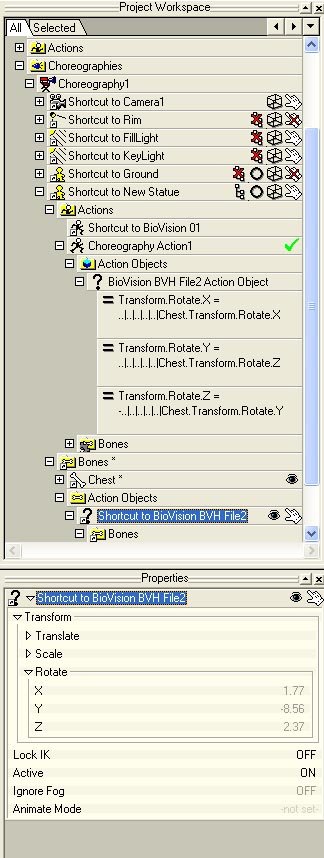-
Posts
623 -
Joined
-
Last visited
Content Type
Profiles
Forums
Events
Everything posted by Luuk Steitner
-
The rotate W is part of the Quaternion rotation and compensates the rotate X so the magnitude = sqrt(w2 + x2 + y2 + z2) is always 1. I don't know what causes the strange highlights.
-
How long is your action? Maybe you can give it a try with short action (a few seconds) and see what is baked.
-
Same problem here (also v14) Time for a report I guess. I does work from the chor for me.
-
I found the problem. The FPS is calculated by the rate divided by the scale (that's the normal way to do that from the AVI params) but those values are integers and in the programmed code therefore the result also was an integer. So when the result must be 29.97 it appeared to be 29 I have modified the calculation method and the FPS is calculated correctly now. I'm planning to upload the next upgrade this weekend. Can you wait this long?
-
Thanks for the info. I'll try to find out what causes this and fix it. EDIT: Wait, at 29.97 the interval should be 0.0333667 in stead of 0.034483. So it's wrong, but not like you say. An interval of 0.033333 would mean 30 FPS, not 29.97
-
You could take a look at the Squetchy rig wiki. There are several tutorials there. You don't have to use the Squetchy rig if you don't want to but it will give you an idea how you can rig a face. Also, you don't have to use a face rig that controls all facial features. You can use the BVH rig to drive muscle poses as well. At the tutorial page there should be plenty info about this.
-
I wonder if the A:M MoCap settings are involved for BVH files. I'll have to test this. That's a great idea, controlling the eyelids with the sneer and eye brow features. I will add more features in a future upgrade so you'll have control of all facial features. Was it easy to stick markers to your eyelids or did you use special markers for that?
-
The frame rate specified in the BVH file is the same as the frame rate of the video you loaded in Zign Track. I don't know what's causing the key frames in A:M to be shorter than one frame. I have had such an issue before (not with BVH) and solved it but that's a long time ago and I don't remember how I solved this back then. If you email me your project file and the BVH file I can take a look at it. Your test looks pretty good though but in one part the mouth hardly moves while you're talking. Was that like your video or did you smooth the mouth too much or something?
-
This forum is for Animation: Master discussion only so a Lightwave thread would be a bit misplaced. I don't know how it's done in Lightwave. I think you should start with looking for a tutorial that explains how to handle a BVH in your app. Or, buy Animation: Master
-
If one gets an message about a missing component he does not have the latest version of Quicktime. If one only sees the Q, it's just not downloading or taking a long time to download.
-
Please send bug reports to support@zigncreations.com Tell me if the program itself is showing or not.
-
With a slow camera like that the chance of feature swapping gets really big. If the markers are close together and you move, it could be that a marker has moved to the position of it's neighbor on the next frame. 10 FPS is probably too slow for good results (it sure is too slow for lip syncing). But if you like to play with it first you'll have to manually adjust the first 3 dots first. You can place the features on some frames were it's hard too track by hand and track again till the neck, fore head and chin feature are tracked correctly. Once those are tracked like it should the Motion guide will use this features as reference to predict the position of other features. Check other features per pair and try to track them. Lock the features that are tracked correctly to save some time. If this is not working out like you want you really need a better camera.
-
I didn't expect that. It appears in A:M like it's baked so I assumed it was. I wonder why capturing a sequence takes a minute but reloading the action does not. Maybe it is baked but deleted when the BVH file is missing. This could be tested by swapping names of BVH files to see if the other action is loaded. I'll check it out later.
-
When you capture a BVH sequence the animation is baked into the action. After this the BVH file is not needed anymore, if I'm right. I give my actions any name I want, that shouldn't matter as long it's obvious to you which action it is. I was planning to add contrast/color adjustment in a future upgrade. But experimenting with the configuration settings should always do the trick if the lighting of your video is good. I understand it's not always easy to get good lighting so adding such a control might add value for some people. I was able to track all my videos without having to edit them first. Some of them were pretty bad.
-
Did you try closing your action/chor windows and reopening them? Sometimes that solves things like this.
-
You're right David, but constraining the face bones directly to the BVH rig is easier to do for those who aren't that experienced with setting up poses, expressions etc. Rotating the BVH rig is a simple solution, but I think your method of driving the face is the best way to do it.
-
Cronos, I have found a very simple solution. The BVH root can be rotated by expressions in the chor. To make it orient like the chest: 1. Select the model under the chor in the PWS. 2. switch "show more than drivers" on 3. switch to skeletal mode 4. click on the BVH rig in the chor window 5. now one of the BVH bones is selected select the "shortcut to BioVision BVH File1" in the PWS 6. in the properties window open transform->Rotate 7. select rotate X, right click, choose edit expression. in the expression for Transform.Rotate.X add: "..|..|..|..|..|Chest.Transform.Rotate.X" 8. now, select the rotate Y property in the same way. in the expression for Transfrom.Rotate.Y add: "..|..|..|..|..|Chest.Transform.Rotate.Z" 9. now, select the rotate Z property in the same way. in the expression for Transfrom.Rotate.Z add: "-..|..|..|..|..|Chest.Transform.Rotate.Y" Note: The 'Y' is controlled by the 'Z' of the chest and the 'Z' by the inverted 'Y'. this is because the orientation of the bones is different. Now the head should move when you move the chest. FrenchMan_Expression.zip
-
I'm getting some more questions from MAC users asking if they can run my app on a MAC with VM or parallels. Is there anyone out there with a MAC with Windows who is willing to try if it works?
-
Thanks David, it's clear to me. I hope this won't be too hard for some people
-
Apparently it's not possible to add an orient like constraint to the BVH object. I was taking a look at the Squetch rig because it works OK with that rig, although you have to rotate the head by hand. I noticed David used expressions to constrain the Squetch face. I'm not sure if that is what makes the difference. David, if you read this; how did you do it? A simple workaround would be to add a model with just the face rig and constrain that rig to the BVH rig. Add that model to the chor, constrain the root bone of that rig to orient like the chest of your model, and orient the face to the face rig. I'm sure there must be better ways to do this (like David's) so any suggestions would be welcome.
-
In case of the Zign Track BVH files is not not necessary to rotate/scale/position the rig. You only need the 'orient like' constraints (with compensate) Only the rotation of the BVH bones is used. I should make special tutorial for this but I don't have time for it at the moment. I found the use of BVH files very easy when I did it the first time. I hope others will find it's easy too. (is that correct english? )
-
If you get a message about the project file being incorrect I would think the file is corrupted. If you can post the file we can take a look at it. Are you able to save new project files and open them?
-
It is a great first test Ernest. Thank you for showing this.
-
Not all MoCap software is that expensive. It could be done with Syntheyes too, but it will still cost you a lot more, you will be needing more cameras and it's much more difficult to use. With some practicing you can achieve pretty good results with Zign Track. Some people out there get better results than I do The results you get with those very expensive software might be a little bit better, but I'm working on some improvements to really compete with their results. It will take some time and feedback from other users to make it better, so my question to all Zign Track users: Show us your results and tell me how you think it could be improved. Together we can make it better than good enough (oh, and; please buy it... LOL)
-
No holidays for me... 1. The background color in the chor is set the background color in the camera properties. The color on the floor in the default chor is caused by the light color of the rim. You can alter the surface properties of the ground or just the light color of the rim. 2. If you want to connect bones in a model, open the bones tree-view and make the bones you want to connect parent-child by dragging them.










